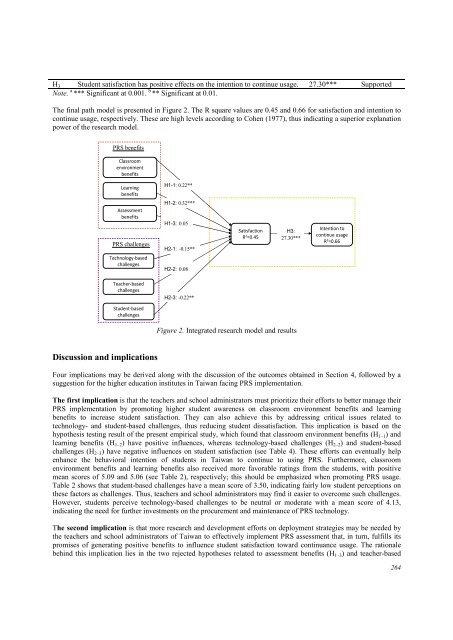Download Complete Issue in PDF - Educational Technology & Society
Download Complete Issue in PDF - Educational Technology & Society
Download Complete Issue in PDF - Educational Technology & Society
Create successful ePaper yourself
Turn your PDF publications into a flip-book with our unique Google optimized e-Paper software.
H3 Student satisfaction has positive effects on the <strong>in</strong>tention to cont<strong>in</strong>ue usage. 27.30*** Supported<br />
Note. a *** Significant at 0.001. b ** Significant at 0.01.<br />
The f<strong>in</strong>al path model is presented <strong>in</strong> Figure 2. The R square values are 0.45 and 0.66 for satisfaction and <strong>in</strong>tention to<br />
cont<strong>in</strong>ue usage, respectively. These are high levels accord<strong>in</strong>g to Cohen (1977), thus <strong>in</strong>dicat<strong>in</strong>g a superior explanation<br />
power of the research model.<br />
PRS benefits<br />
Classroom<br />
environment<br />
benefits<br />
Learn<strong>in</strong>g<br />
benefits<br />
Assessment<br />
benefits<br />
PRS challenges<br />
<strong>Technology</strong>-based<br />
challenges<br />
Teacher-based<br />
challenges<br />
Student-based<br />
challenges<br />
Discussion and implications<br />
H1-1: 0.22**<br />
H1-2: 0.32***<br />
H1-3: 0.05<br />
H2-1: -0.15**<br />
H2-2: 0.08<br />
H2-3: -0.22**<br />
Satisfaction<br />
R 2 =0.45<br />
H3:<br />
27.30***<br />
Figure 2. Integrated research model and results<br />
Intention to<br />
cont<strong>in</strong>ue usage<br />
R 2 =0.66<br />
Four implications may be derived along with the discussion of the outcomes obta<strong>in</strong>ed <strong>in</strong> Section 4, followed by a<br />
suggestion for the higher education <strong>in</strong>stitutes <strong>in</strong> Taiwan fac<strong>in</strong>g PRS implementation.<br />
The first implication is that the teachers and school adm<strong>in</strong>istrators must prioritize their efforts to better manage their<br />
PRS implementation by promot<strong>in</strong>g higher student awareness on classroom environment benefits and learn<strong>in</strong>g<br />
benefits to <strong>in</strong>crease student satisfaction. They can also achieve this by address<strong>in</strong>g critical issues related to<br />
technology- and student-based challenges, thus reduc<strong>in</strong>g student dissatisfaction. This implication is based on the<br />
hypothesis test<strong>in</strong>g result of the present empirical study, which found that classroom environment benefits (H1–1) and<br />
learn<strong>in</strong>g benefits (H1–2) have positive <strong>in</strong>fluences, whereas technology-based challenges (H2–2) and student-based<br />
challenges (H2–3) have negative <strong>in</strong>fluences on student satisfaction (see Table 4). These efforts can eventually help<br />
enhance the behavioral <strong>in</strong>tention of students <strong>in</strong> Taiwan to cont<strong>in</strong>ue to us<strong>in</strong>g PRS. Furthermore, classroom<br />
environment benefits and learn<strong>in</strong>g benefits also received more favorable rat<strong>in</strong>gs from the students, with positive<br />
mean scores of 5.09 and 5.06 (see Table 2), respectively; this should be emphasized when promot<strong>in</strong>g PRS usage.<br />
Table 2 shows that student-based challenges have a mean score of 3.50, <strong>in</strong>dicat<strong>in</strong>g fairly low student perceptions on<br />
these factors as challenges. Thus, teachers and school adm<strong>in</strong>istrators may f<strong>in</strong>d it easier to overcome such challenges.<br />
However, students perceive technology-based challenges to be neutral or moderate with a mean score of 4.13,<br />
<strong>in</strong>dicat<strong>in</strong>g the need for further <strong>in</strong>vestments on the procurement and ma<strong>in</strong>tenance of PRS technology.<br />
The second implication is that more research and development efforts on deployment strategies may be needed by<br />
the teachers and school adm<strong>in</strong>istrators of Taiwan to effectively implement PRS assessment that, <strong>in</strong> turn, fulfills its<br />
promises of generat<strong>in</strong>g positive benefits to <strong>in</strong>fluence student satisfaction toward cont<strong>in</strong>uance usage. The rationale<br />
beh<strong>in</strong>d this implication lies <strong>in</strong> the two rejected hypotheses related to assessment benefits (H1–3) and teacher-based<br />
264

















